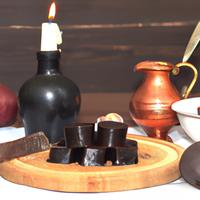
1 serving (30 grams) contains 112 calories, 1.5 grams of protein, 0.1 grams of fat, and 25.5 grams of carbohydrates.

Log this food in SnapCalorie

Nutrition Information
Calories |
885.8 | ||
|---|---|---|---|
% Daily Value* |
|||
| Total Fat | 1.2 g | 1% | |
| Saturated Fat | 0.2 g | 1% | |
| Polyunsaturated Fat | 0 g | ||
| Cholesterol | 0 mg | 0% | |
| Sodium | 118.1 mg | 5% | |
| Total Carbohydrates | 200.8 g | 73% | |
| Dietary Fiber | 0 g | 0% | |
| Sugars | 153.5 g | ||
| protein | 11.8 g | 23% | |
| Vitamin D | 0 mcg | 0% | |
| Calcium | 47.2 mg | 3% | |
| Iron | 1.2 mg | 6% | |
| Potassium | 118.1 mg | 2% | |
* Percent Daily Values are based on a 2,000 calorie diet. Your daily values may be higher or lower depending on your calorie needs.
Food Attributes
Source of Calories
About Lakris
Lakris, commonly known as licorice, is a confection traditionally made from the extract of the licorice plant's root, combined with sugar and a binder such as flour. Originating from Scandinavia and Northern Europe, it is popular in both sweet and salted varieties, with the latter incorporating ammonium chloride for its signature tangy taste. Licorice contains glycyrrhizin, a compound that imparts its characteristic sweetness and may offer anti-inflammatory and antiviral benefits. However, excessive consumption can lead to increased blood pressure and electrolyte imbalances due to glycyrrhizin's effects. It is often complemented with flavorings like anise or menthol, and modern versions may include artificial substitutes for licorice extract. While Lakris can be enjoyed as part of traditional Nordic cuisine, moderation is key to avoid potential health risks. For a lower-sugar option, check for versions made with natural sweeteners or less added sugar.



